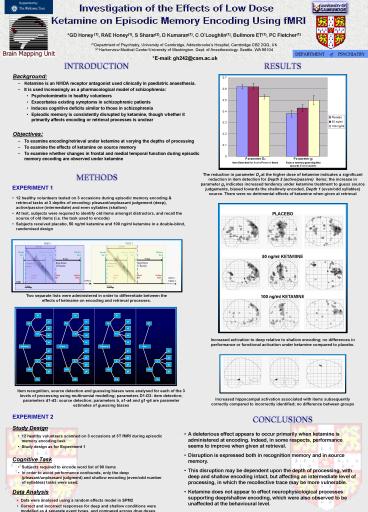Background: - PowerPoint PPT Presentation
1 / 1
Title:
Background:
Description:
... is an NMDA receptor antagonist used clinically in paediatric anaesthesia. It is used increasingly as a pharmacological model of schizophrenia: ... – PowerPoint PPT presentation
Number of Views:21
Avg rating:3.0/5.0
Title: Background:
1
GD Honey (1), RAE Honey(1), S Sharar(2), D
Kumaran(1), C OLoughlin(1), Bullmore ET(1), PC
Fletcher(1)
(1)Department of Psychiatry, University of
Cambridge, Addenbrookes Hospital, Cambridge CB2
2QQ, UK (2) Harborview Medical Center/University
of Washington. Dept. of Anesthesiology. Seattle,
WA 98104
E-mail gh242_at_cam.ac.uk
- Background
- Ketamine is an NMDA receptor antagonist used
clinically in paediatric anaesthesia. - It is used increasingly as a pharmacological
model of schizophrenia - Psychotomimetic in healthy volunteers
- Exacerbates existing symptoms in schizophrenic
patients - Induces cognitive deficits similar to those in
schizophrenia - Episodic memory is consistently disrupted by
ketamine, though whether it primarily affects
encoding or retrieval processes is unclear - Objectives
- To examine encoding/retrieval under ketamine at
varying the depths of processing - To examine the effects of ketamine on source
memory - To examine whether changes in frontal and medial
temporal function during episodic memory encoding
are observed under ketamine
The reduction in parameter D2 at the higher dose
of ketamine indicates a significant reduction in
item detection for Depth 2 (active/passive)
items the increase in parameter g1 indicates
increased tendency under ketamine treatment to
guess source judgements, biased towards the
shallowly encoded, Depth 1 (even/odd syllables)
source. There were no detrimental effects of
ketamine when given at retrieval
EXPERIMENT 1
- 12 healthy volunteers tested on 3 occasions
during episodic memory encoding retrieval tasks
at 3 depths of encoding pleasant/unpleasant
judgement (deep), active/passive (intermediate)
and even syllables (shallow) - At test, subjects were required to identify old
items amongst distractors, and recall the source
of old items (i.e. the task used to encode) - Subjects received placebo, 50 ng/ml ketamine and
100 ng/ml ketamine in a double-blind, randomised
design
PLACEBO
50 ng/ml KETAMINE
Two separate lists were administered in order to
differentiate between the effects of ketmaine on
encoding and retrieval processes.
100 ng/ml KETAMINE
Increased activation to deep relative to shallow
encoding no differences in performance or
functional activation under ketamine compared to
placebo.
Item recognition, source detection and guessing
biases were analysed for each of the 3 levels of
processing using multinomial modelling
parameters D1-D3 item detection parameters
d1-d3 source detection parameters b, a1-a4 and
g1-g4 are parameter estimates of guessing biases
Increased hippocampal activation associated with
items subsequently correctly compared to
incorrectly identified no difference between
groups
EXPERIMENT 2
Study Design
- A deleterious effect appears to occur primarily
when ketamine is administered at encoding.
Indeed, in some respects, performance seems to
improve when given at retrieval. - Disruption is expressed both in recognition
memory and in source memory. - This disruption may be dependent upon the depth
of processing, with deep and shallow encoding
intact, but affecting an intermediate level of
processing, in which the recollective trace may
be more vulnerable. - Ketamine does not appear to effect
neurophysiological processes supporting
deep/shallow encoding, which were also observed
to be unaffected at the behavioural level.
- 12 healthy volunteers scanned on 3 occasions at
3T fMRI during episodic memory encoding task - Study design as for Experiment 1
Cognitive Task
- Subjects required to encode word list of 90 items
- In order to avoid performance confounds, only the
deep (pleasant/unpleasant judgment) and shallow
encoding (even/odd number of syllables) tasks
were used.
Data Analysis
- Data were analysed using a random effects model
in SPM2 - Correct and incorrect responses for deep and
shallow conditions were modelled as 4 separate
event types, and compared across drug doses.































